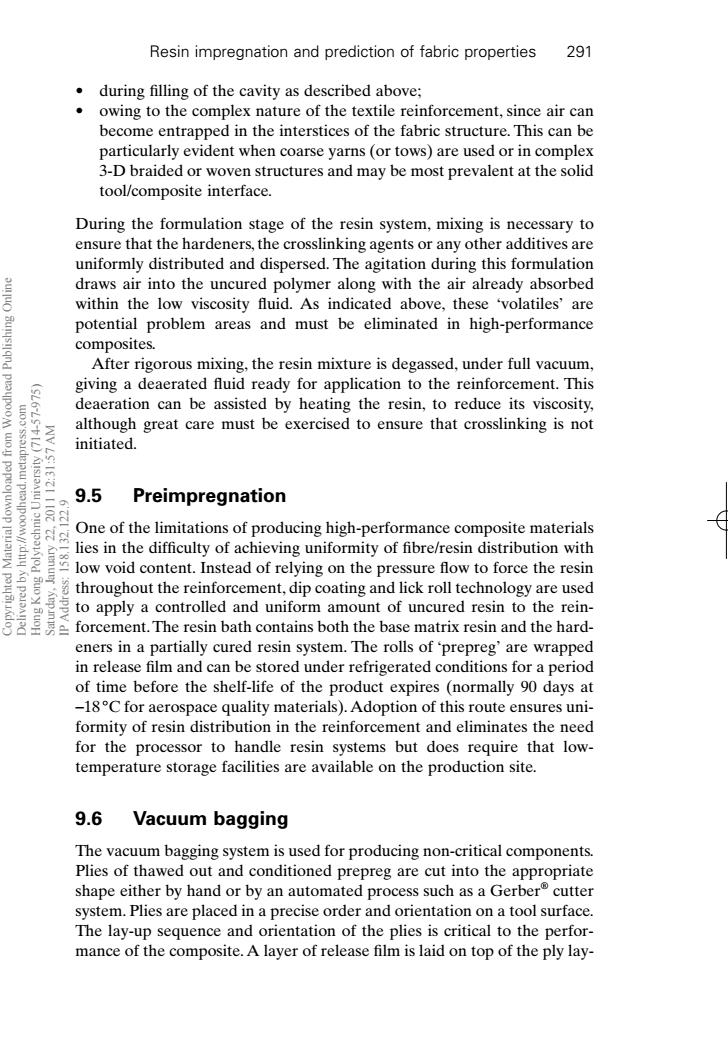正在加载图片...

Resin impregnation and prediction of fabric properties 291 during filling of the cavity as described above; owing to the complex nature of the textile reinforcement,since air can become entrapped in the interstices of the fabric structure.This can be particularly evident when coarse yarns(or tows)are used or in complex 3-D braided or woven structures and may be most prevalent at the solid tool/composite interface. During the formulation stage of the resin system,mixing is necessary to ensure that the hardeners,the crosslinking agents or any other additives are uniformly distributed and dispersed.The agitation during this formulation draws air into the uncured polymer along with the air already absorbed within the low viscosity fluid.As indicated above,these 'volatiles'are potential problem areas and must be eliminated in high-performance composites. After rigorous mixing,the resin mixture is degassed,under full vacuum, giving a deaerated fluid ready for application to the reinforcement.This deaeration can be assisted by heating the resin,to reduce its viscosity, although great care must be exercised to ensure that crosslinking is not initiated. 9.5 Preimpregnation One of the limitations of producing high-performance composite materials lies in the difficulty of achieving uniformity of fibre/resin distribution with low void content.Instead of relying on the pressure flow to force the resin throughout the reinforcement,dip coating and lick roll technology are used to apply a controlled and uniform amount of uncured resin to the rein- 8 forcement.The resin bath contains both the base matrix resin and the hard- eners in a partially cured resin system.The rolls of prepreg'are wrapped in release film and can be stored under refrigerated conditions for a period of time before the shelf-life of the product expires (normally 90 days at -18C for aerospace quality materials).Adoption of this route ensures uni- formity of resin distribution in the reinforcement and eliminates the need for the processor to handle resin systems but does require that low- temperature storage facilities are available on the production site. 9.6 Vacuum bagging The vacuum bagging system is used for producing non-critical components. Plies of thawed out and conditioned prepreg are cut into the appropriate shape either by hand or by an automated process such as a Gerber cutter system.Plies are placed in a precise order and orientation on a tool surface. The lay-up sequence and orientation of the plies is critical to the perfor- mance of the composite.A layer of release film is laid on top of the ply lay-• during filling of the cavity as described above; • owing to the complex nature of the textile reinforcement, since air can become entrapped in the interstices of the fabric structure. This can be particularly evident when coarse yarns (or tows) are used or in complex 3-D braided or woven structures and may be most prevalent at the solid tool/composite interface. During the formulation stage of the resin system, mixing is necessary to ensure that the hardeners, the crosslinking agents or any other additives are uniformly distributed and dispersed. The agitation during this formulation draws air into the uncured polymer along with the air already absorbed within the low viscosity fluid. As indicated above, these ‘volatiles’ are potential problem areas and must be eliminated in high-performance composites. After rigorous mixing, the resin mixture is degassed, under full vacuum, giving a deaerated fluid ready for application to the reinforcement. This deaeration can be assisted by heating the resin, to reduce its viscosity, although great care must be exercised to ensure that crosslinking is not initiated. 9.5 Preimpregnation One of the limitations of producing high-performance composite materials lies in the difficulty of achieving uniformity of fibre/resin distribution with low void content. Instead of relying on the pressure flow to force the resin throughout the reinforcement, dip coating and lick roll technology are used to apply a controlled and uniform amount of uncured resin to the reinforcement. The resin bath contains both the base matrix resin and the hardeners in a partially cured resin system. The rolls of ‘prepreg’ are wrapped in release film and can be stored under refrigerated conditions for a period of time before the shelf-life of the product expires (normally 90 days at -18 °C for aerospace quality materials). Adoption of this route ensures uniformity of resin distribution in the reinforcement and eliminates the need for the processor to handle resin systems but does require that lowtemperature storage facilities are available on the production site. 9.6 Vacuum bagging The vacuum bagging system is used for producing non-critical components. Plies of thawed out and conditioned prepreg are cut into the appropriate shape either by hand or by an automated process such as a Gerber® cutter system. Plies are placed in a precise order and orientation on a tool surface. The lay-up sequence and orientation of the plies is critical to the performance of the composite. A layer of release film is laid on top of the ply layResin impregnation and prediction of fabric properties 291 RIC9 7/10/99 8:32 PM Page 291 Copyrighted Material downloaded from Woodhead Publishing Online Delivered by http://woodhead.metapress.com Hong Kong Polytechnic University (714-57-975) Saturday, January 22, 2011 12:31:57 AM IP Address: 158.132.122.9